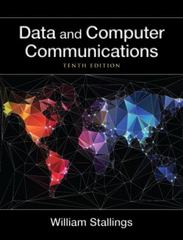By far, the most widely used technique for pseudorandom number generation is the linear congruential method. The
Question:
By far, the most widely used technique for pseudorandom number generation is the linear congruential method. The algorithm is parameterized with four numbers, as follows:
m the modulus m 7 0 a the multiplier 0 … a 6 m c the increment 0 … c 6 m X0 the starting value, or seed 0 … X0 6 m The sequence of pseudorandom numbers {Xn} is obtained via the following iterative equation:
Xn+1 = (aXn +
c) mod m If m,
a, c, and X0 are integers, then this technique will produce a sequence of integers with each integer in the range 0 … Xn 6 m. An essential characteristic of a pseudorandom number generator is that the generated sequence should appear random.
Although the sequence is not random, because it is generated deterministically, there is a variety of statistical tests that can be used to assess the degree to which a sequence exhibits randomness. Another desirable characteristic is that the function should be a full-period generating function. That is, the function should generate all the numbers between 0 and m before repeating.
With the linear congruential algorithm, a choice of parameters that provides a full period does not necessarily provide a good randomization. For example, consider the two generators:
Xn+1 = (6Xn) mod 13 Xn+1 = (7Xn) mod 13 Write out the two sequences to show that both are full period. Which one appears more random to you?
Step by Step Answer:







